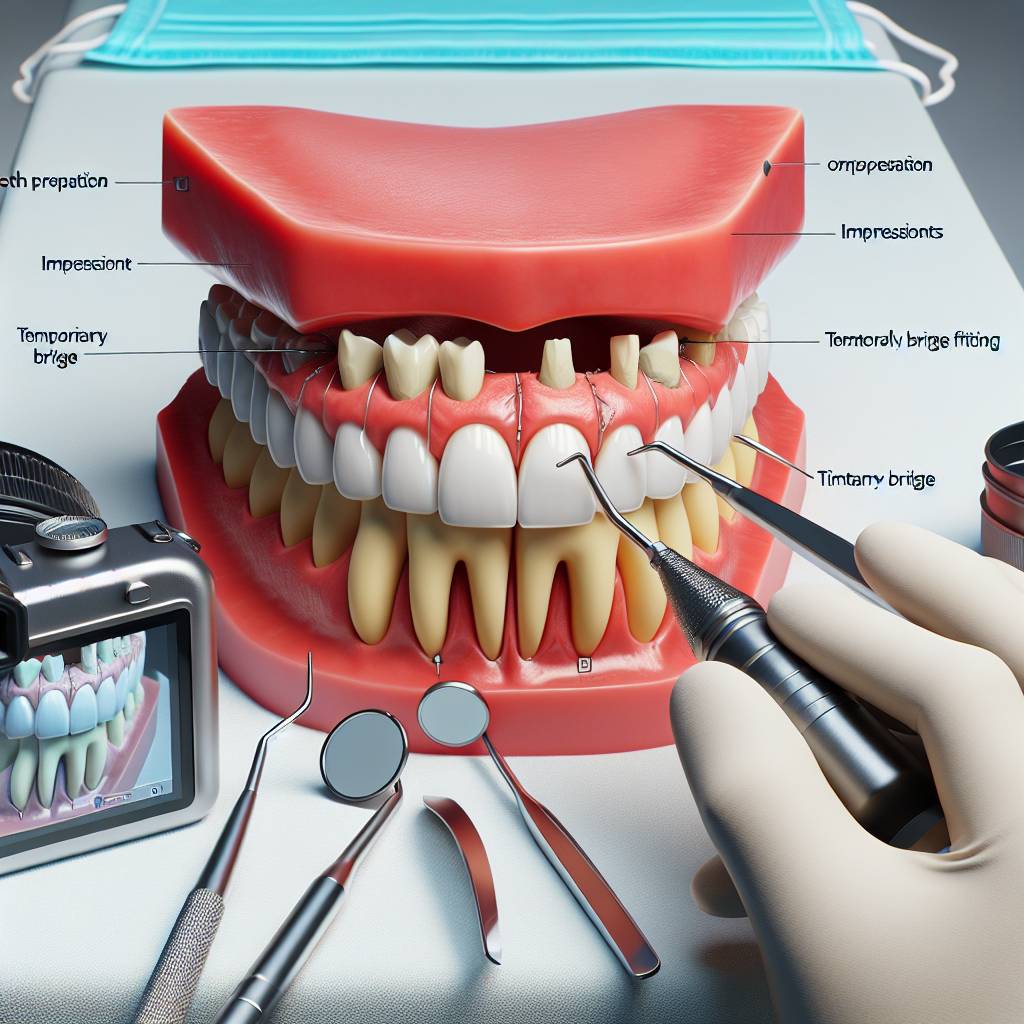A bridge for teeth is a dental restoration used to replace missing teeth. It is typically made up of two crowns that are placed on the abutment teeth on either side of the gap, with a false tooth in between that is attached to the crowns. The bridge is usually secured in place with a strong bonding material, such as dental cement. The bridge can be made from porcelain, metal alloys, or various combinations of these materials. The type of material used depends on the patient’s specific needs and preferences.The materials used to make a bridge for teeth usually include metal, porcelain, or a combination of both. The metal is typically made of gold or another alloy, while the porcelain is designed to match the color of the patient’s natural teeth.
How Do Dentists Prepare Teeth for a Bridge?
When a patient needs a bridge to replace one or more missing teeth, there are several steps that must be taken in order to prepare the teeth. The dentist will first examine the mouth and take x-rays to determine the best way to proceed. Then, the dentist will prepare the teeth on either side of the gap for crowns. This process includes removing any decay or old fillings and reshaping the teeth so that crowns can be placed over them.
Next, impressions of the prepared teeth are taken and sent off to a dental lab. The impressions are used by technicians at the lab to create custom-made crowns that fit perfectly over each tooth. While this is happening, temporary crowns may be placed over the prepared teeth until permanent crowns arrive.
Once all of the parts have been created and fitted together, they are bonded into place with special cement. Finally, your dentist will check your bite and make sure that everything fits together correctly before you leave their office with a bridge in place.
Having a bridge placed is an important step in restoring your smile and oral health, so it’s important that all steps are taken correctly so you can enjoy your new bridge for years to come.
What Is The Process of Making a Bridge for Teeth?
The process of making a bridge for teeth typically involves two dental visits. During the first visit, the dentist will prepare the surrounding teeth to ensure that they can support the bridge. An impression of your teeth will be taken and sent off to a laboratory, where your custom bridge will be fabricated.
On your second visit, the dentist will check to make sure that the bridge fits properly. The bridge may need to be adjusted to make sure it fits comfortably in your mouth. Once satisfied, the dentist will cement or bond it into place.
After placement, you may experience some sensitivity due to the placement of the bridge and surrounding teeth being altered. However, this should subside after a few days. Your dentist may also recommend using fluoride or desensitizing toothpaste to help with any post-treatment sensitivity issues you may experience.
Your dentist may also advise that you schedule regular follow-up visits in order to check how well your new bridge is performing and if any adjustments need to be made. With proper care and maintenance, bridges can last up to 10 years or more before they need replacing.
It’s important to maintain good oral hygiene habits even with a dental bridge in place as bacteria can still accumulate around the edges of it and cause problems such as gum disease or decay.
How Long Does It Take to Make a Bridge for Teeth?
The process of creating a bridge for teeth can vary greatly depending on the complexity of each patient’s case. Generally, it takes at least two appointments to complete the process. During the first appointment, impressions of the patient’s teeth will be taken and a mold will be created. The dentist will then use that mold to create a custom bridge for the patient.
In some cases, the bridge may be ready during the second appointment and can be placed with minimal adjustments. However, if more complex adjustments or customizations are needed, it may take longer than two visits before the final bridge is ready. The dentist may also need to make adjustments or modifications onsite during final placement of the bridge.
In most cases, it takes between two to three weeks from start to finish for a bridge to be made and fitted. This includes time for creating the mold and manufacturing the bridge as well as time for any necessary adjustments or modifications that need to be made before placing it in the patient’s mouth.
It is important to work closely with your dentist throughout this process so that you can get an idea of how long it will take before your new dental bridge is ready for use.
What Are the Benefits of Getting a Bridge for Teeth?
Getting a bridge for teeth can provide many benefits to your oral health. These include improved aesthetics, better bite and chewing function, and increased stability of adjacent teeth. Bridges can also help to prevent further dental problems such as gum disease or tooth decay. Additionally, a bridge can improve the overall look of your smile by providing even spacing between your teeth and creating a symmetrical appearance. Bridges are also an effective way to replace missing teeth, as they offer a permanent solution that won’t need to be replaced over time like dentures or implants. Finally, bridges are relatively easy to maintain and can last for many years with proper care and regular visits to the dentist.
Overall, getting a bridge for your teeth is an excellent way to maintain good oral health and improve the look of your smile. Not only will you enjoy the benefits of better bite and chewing function, but you’ll also be protecting adjacent teeth from further damage while improving the aesthetics of your smile. With proper care and regular dental check-ups, bridges can last for many years, making them an ideal choice for those looking for a permanent solution for missing teeth.

What Are The Different Types of Bridges For Teeth?
Bridges are a common dental procedure used to replace missing teeth. They consist of two crowns, which are placed on the teeth adjacent to the gap and a false tooth, known as a pontic, in between. There are several different types of bridges that can be used depending on the situation and patient preference. The most common types of bridges are traditional bridges, cantilever bridges, Maryland bonded bridges, and implant-supported bridges.
Traditional Bridges involve placing crowns on the adjacent teeth and attaching the pontic in between them. This is sometimes referred to as a “fixed bridge” because it is permanently cemented into place. Traditional bridges are usually made out of porcelain or ceramic materials that match the color of your natural teeth for an aesthetically pleasing result.
Cantilever Bridges are similar to traditional bridges but they only have one supporting crown instead of two. This type of bridge is typically used when there is only one tooth adjacent to the gap instead of two.
Maryland Bonded Bridges use metal framework wings attached to the back side of adjoining teeth and then bonded directly onto the existing enamel with resin material or metal bands. These types of bridges are typically only used in front teeth due to their strength limitations.
Implant-supported Bridges use dental implants placed in each end of the gap and then attached to prosthetic teeth for a secure hold. Implant-supported bridges can be used when there is no natural tooth left adjacent to the gap or when there isn’t enough bone structure remaining for traditional bridgework to be done safely and securely.
Each type of bridge has its own advantages and disadvantages so it’s important to discuss all options with your dentist before making a decision about which type is best for you. With proper care and maintenance, your bridge should last many years and provide you with a beautiful smile!
How Much Does it Cost to Get a Bridge For Teeth?
The cost of getting a bridge for your teeth can vary depending on the type of bridge you choose and the complexity of your case. Generally, the cost of a bridge ranges from $500 to $1,500 per tooth. Additional costs may be required if you need a root canal or other treatments prior to having the bridge placed.
If you need more than one tooth replaced, bridges can become quite expensive. A three-unit bridge typically starts at around $2,000 and can go up from there. If you have several missing teeth in an arch, the cost for a full arch or full mouth reconstruction could easily exceed $20,000.
Some dental insurance plans help cover the cost of bridges, although it is important to check with your provider beforehand to see what is covered under your plan. If your insurance does not cover bridges, financing options are available through dental offices and healthcare providers that allow you to spread out payments over time.
It is also important to consider that although bridges can be expensive upfront, they provide long-term benefits that make them well worth the investment. Bridges are considered permanent fixtures that restore both form and function for missing teeth and can last 10-15 years or longer with proper care and maintenance.
What Kind of Aftercare Is Needed When Getting a Bridge For Teeth?
After getting a bridge for teeth, it is important to take care of it properly in order to ensure its longevity and effectiveness. It is important to brush and floss your teeth regularly and visit the dentist every 6 months for check-ups. Proper brushing techniques are essential; the bridge should be brushed in the same manner as regular teeth, including the area underneath the bridge.
It is also important to avoid hard or crunchy foods that can damage or dislodge the bridge. These include hard candy, ice, popcorn kernels, or anything else that might be too hard for your bridge. Additionally, avoiding sticky foods like caramels or taffy can help keep your bridge secure.
It is important to note that after getting a new bridge, you may experience some sensitivity due to the new structure in your mouth. This may last a few days and can usually be managed with over-the-counter pain medications such as ibuprofen or acetaminophen. If sensitivity persists longer than a few days or worsens over time, it is important to contact your dentist as soon as possible.
Overall, proper aftercare for bridges involves regular brushing and flossing as well as avoiding certain types of food that can damage or dislodge the bridge. Additionally, if sensitivity persists beyond a few days after getting the bridge, it is important to contact your dentist right away. With proper care and maintenance, bridges can last many years and help restore function and aesthetics to smiles!

Conclusion
Making a bridge for teeth is a complicated process involving several steps. It begins with the preparation of the abutment teeth, followed by obtaining an impression of the teeth and casting the bridge. The bridge is then fitted onto the abutment teeth, and finally polished and adjusted to ensure it fits correctly. With proper care and maintenance, a dental bridge can last for many years.
Dental bridges are an effective way to replace missing teeth, restoring both function and aesthetics to your smile. Before you get a dental bridge, it is important to discuss your options with your dentist so you can make an informed decision about what kind of restoration is best for you.

